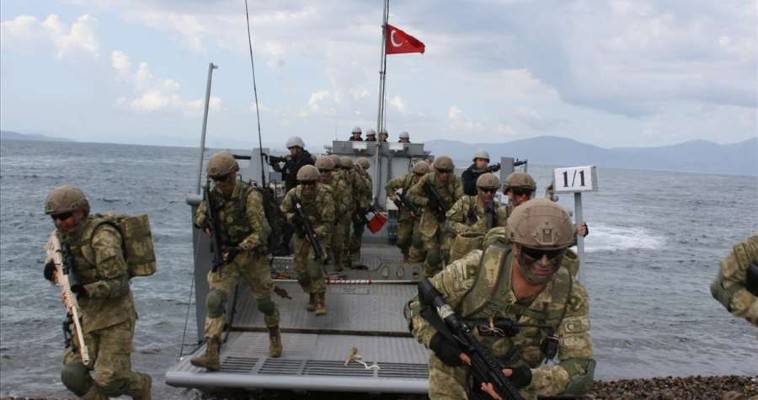Efthymios Tsiliopoulos: Can the small islands of the Aegean be defended from Turkish invasion?
22/01/2021
The Turkish military threat focuses on the many small islands of the eastern Aegean. Some of them are located further west than the large islands and are therefore the least vulnerable and will not concern us at this time. The small islands near the Turkish coast are an easy target for amphibious operations in order to create a fait accompli.
Ankara claims 152 small islands and islets as “Turkish”. “Greece only has a de facto rule of sovereignty over the islands called EGAYDAAK and its administration there does not negate the fact that these islands are territory of the Turkish Republic,” Turkish Foreign Minister Cavusoglu told the National Assembly in 2018.
The acronym EGAYDAAK (Egemenligi Anlasmalarla Yunanistan’a devredilmemis Ada Adacik ve Kayaliklar) denotes islands and islets whose ownership (according to the Turks) was not granted to Greece by agreements. In case of conflict, the main targets will be on the one hand the Kastellorizo complex (due to distance and EEZ), on the other hand the 152 EGAYDAAK.
Many of them are uninhabited, arid, and deprived of tall flora, which is not suitable for defense. The same goes for anyone who lands on them. The attacker may easily take them, but he can not stay on them unless he is willing to make superhuman efforts to support them. In addition, uninhabited islands can receive a hail of naval and air strikes, as well as artillery fire from nearby larger islands, without fear of inflicting friendly losses.
Possible targets are Fourni, Thymaina, Oinousses, Ikaria, Agathonisi, Syrna, Kinaros, Gyali, Plati, Kalolimnos, Farmakonisi, Arkoi, all on the list of “Turkish islands under Greek occupation”! The problem is the small islands that are inhabited and the occupation of which is not just a matter of prestige or loss of land, but also of foreign occupation on Greek citizens.
The defensive landscape on the small islands
The small islands are usually rocky with steep mountain and semi-mountainous masses and with few beaches offered for landing. On some only the ports can be used for landing, while others can be approached only by small boats or helicopters.
The dilemma for ASDEN (Senior Military Command of the Interior and Islands) that is in charge of defense in the Aegean is how much it will disperse its forces and to which islands, which units it will keep as a reserve and how it will use them. As we mentioned in a previous article about the defense on the larger islands, they have enough forces to defend themselves, causing serious losses to the opponent.
On smaller islands, however, there are battalion-sized forces, or simply outposts manned by a squad or a platoon. That is forces that can be easily neutralized if the enemy attacks them with much stronger forces. In case of a sudden assault on a small inhabited island, he will use preparatory fire to “soften” the defense, without calculating the losses of civilians. In Kastellorizo, in fact, he may seek the annihilation of the inhabitants and its colonization, in order to consolidate the Turkish occupation.
The Japanese masters of defense on small islands
The art of fortification and defense of small islands reached its peak by the Japanese. During World War II, they defended themselves on complexes of small islands throughout the Pacific, some of which were volcanic and others coral atolls. On the rocky islands, the Japanese made the most of the terrain and all the local materials to create fortifications. Minimal concrete or steel could be sent from Japan. They dug into the ground, creating tunnels that connected fortified defensive positions that provided overlapping fire.
Indirect fire weapons, guns, howitzers, and mortars, were mounted on reverse hill slopes behind the ridge so that they could fire but could not be seen by US observers on the shore and could not be exposed to enemy artillery fire. Maximum emphasis was placed on the camouflage of positions, which with great success prevented American reconnaissance aircraft from locating the enemy.
The Japanese defenders let the Americans land on the shores and crowd there before launching heavy artillery fire with all available means. The infantry units stationed on the slopes, or on the reverse side, let the Americans pass between them and hit them when they were now in the midst of crossfire. Great emphasis was also placed on the creation of false positions and vehicles to cause unnecessary fire on the part of the attackers.
What did Leros teach us?
In the case of the Aegean, the question is whether the infantry can manage the defense. In the past, there have been raids and occupation of islands by the Sacred Battalion and British commandos. At the same time, there were painful defeats in Churchill’s campaign to occupy the Dodecanese, with the Battle of Leros (1943) still being taught at military schools today.
The attacking Germans, mainly paratroopers, despite their heavy losses, were initially able to split into two the superior forces of the British and Italian defenders. The lack of communication, however, worked to the detriment of the defenders. The British and Italian forces were found scattered on the island and despite their numerical superiority were cut off and surrendered piecemeal.
Units had no contact with the upper echelons, nor a picture of the progress of the battle. The Italian artillery wasted its ammunition and the Royal Navy was unable to supply the defenders. The Luftwaffe soon gained air supremacy, inflicting heavy losses on the defenders and sinking many ships, including the Greek destroyer “Queen Olga”.
Conditions for successful defense of small islands
The chief prerequisite for successful defense on small islands is preparation. Because the attacker has the initiative of movements, the defender must be constantly alert. Fortunately, due to migratory flows, both the Coast Guard and the Navy are on alert and a number of sensors have also been installed. This has made it very difficult to cross the water borders, preventing, in part, surprise. The Turks, of course, will devise ways to penetrate through the naval forces, or engage them elsewhere to occupy them. It can not be ruled out that Turkish commandos may disguise themselves as immigrants.
We believe that in the air the Greek Air Force will prevail, but again the enemy will try to occupy the Greek forces away from its target. Having involved Navy and Air Force in other places, it will send the attacking forces that will precede (by speedboats or helicopters) and the main amphibious forces that will follow.
Considering that any of the smaller islands can be the target, the responsible commanders should study the terrain and identify places that are offered for defense and alternative places for dispersal and supply. New sites and fortifications must be created, as well as communication trenches. All this requires effort and good knowledge of the ground.
The units must be drilled continuously so that with minimal warning they can occupy the positions predetermined by the plans, arrange the support weapons, but also weapons that will face the landing craft and assault forces. Guided anti-tank weapons will play an important role against slow-moving landing craft. The highest points that give visual surveillance of possible landing points must be constantly manned and soldiers must be aware of the stakes.
Immediate intervention
The Greek Armed Forces are constantly exercising in operations to strengthen small islands after the fiasco in Imia, in 1996. Such operations are carried out by the Amphibious Commando units, the National Guard Special Departments, the 71st Airborne Brigade, paratroopers, commandos, marines, and the 547th Airborne Infantry Battalion.
Unfortunately, the larger islands do not have vessels for transporting infantry and heavy weapons to strengthen the defense on the smaller islands. However, civilian vessels can be requisitioned or on a voluntary basis, but the units have not been trained for such operations. As easy as it may seem to get into a boat and jump down in half a meter of water, it is not easy, let alone with a battle load.
Special forces are trained in the use of a range of means of transport for just such reasons. The infantry, however, which is the backbone of the islands’ defense, does not have the appropriate training to operate “off-site”. It must, therefore, be considered, if it has not already been considered, how to transfer reserves and supplies from larger to smaller islands that will be attacked, without waiting for forces to be transported from mainland Greece by helicopter or ship, exposed to great dangers. Finally, there must be Army Air Force attack helicopters to act against the amphibious forces.
As mentioned above, Kastellorizo, which is at the eastern end of the Greek territory, is in particular danger. That is why special plans must be drawn up for both the transfer of forces and air and naval support. The loss of even the smallest island is a heavy defeat and the operation to recapture it poses great difficulties due to the short distance from the Turkish shores. The operation to recapture an island, however, is an issue for a future article.





